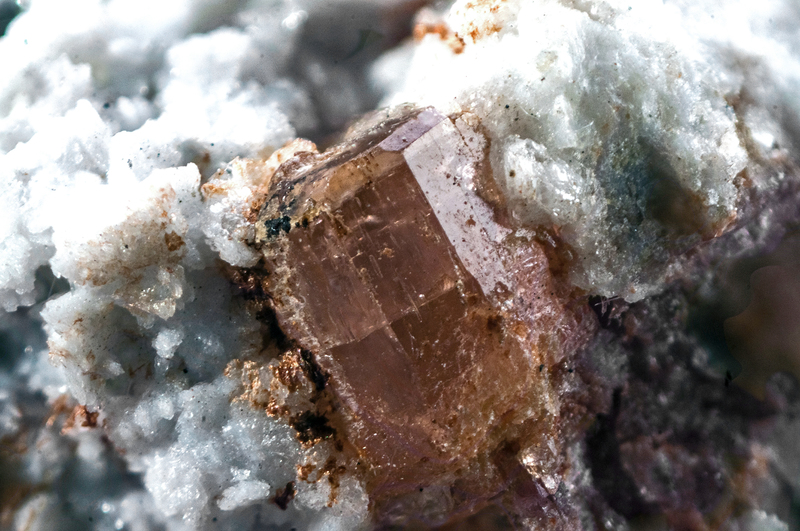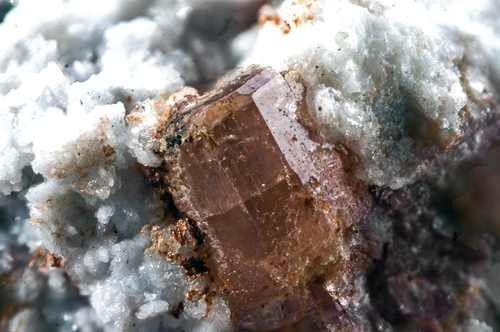Sidorenkite
A valid IMA mineral species
This page is currently not sponsored. Click here to sponsor this page.
About Sidorenkite
Formula:
Na3Mn2+(CO3)(PO4)
Colour:
Colourless, pale pink, brownish, red-brown
Lustre:
Vitreous, Pearly
Hardness:
2
Specific Gravity:
2.90 - 3.03
Crystal System:
Monoclinic
Name:
Named after Alexander Vasil'evich Sidorenko (Александр Васильевич Сидоренко) (6 (19) October 1917, Novo Nikolaevka, Kharkov Governorate, Russian Empire - 23 March 1982, Algeria), a founder of the Kola Scientific Center.
This page provides mineralogical data about Sidorenkite.
Unique Identifiers
Mindat ID:
3653
Long-form identifier:
mindat:1:1:3653:1
GUID
(UUID V4):
(UUID V4):
59a710b6-2a72-4d9a-acd2-0bf9e0d47d51
IMA Classification of Sidorenkite
Approved
IMA Formula:
Na3Mn(PO4)(CO3)
First published:
1979
Classification of Sidorenkite
5.BF.10
5 : CARBONATES (NITRATES)
B : Carbonates with additional anions, without H2O
F : With (Cl), SO4, PO4, TeO3
5 : CARBONATES (NITRATES)
B : Carbonates with additional anions, without H2O
F : With (Cl), SO4, PO4, TeO3
43.2.1.2
43 : COMPOUND PHOSPHATES, ETC.
2 : Anhydrous Normal Compound Phosphates, etc·
43 : COMPOUND PHOSPHATES, ETC.
2 : Anhydrous Normal Compound Phosphates, etc·
19.12.4
19 : Phosphates
12 : Phosphates of Mn
19 : Phosphates
12 : Phosphates of Mn
Mineral Symbols
As of 2021 there are now IMA–CNMNC approved mineral symbols (abbreviations) for each mineral species, useful for tables and diagrams.
| Symbol | Source | Reference |
|---|---|---|
| Sdo | IMA–CNMNC | Warr, L.N. (2021). IMA–CNMNC approved mineral symbols. Mineralogical Magazine, 85(3), 291-320. doi:10.1180/mgm.2021.43 |
Physical Properties of Sidorenkite
Vitreous, Pearly
Transparency:
Transparent
Comment:
pearly on cleavage faces
Colour:
Colourless, pale pink, brownish, red-brown
Comment:
surficial brownish or yellowish tint
Hardness:
2 on Mohs scale
Tenacity:
Brittle
Cleavage:
Perfect
perfect on {100}, {010}, imperfect on {001}
perfect on {100}, {010}, imperfect on {001}
Fracture:
Irregular/Uneven
Density:
2.90 - 3.03 g/cm3 (Measured) 2.98 g/cm3 (Calculated)
Optical Data of Sidorenkite
Type:
Biaxial (-)
RI values:
nα = 1.521(2) nβ = 1.563(2) nγ = 1.585(2)
2V:
Measured: 68° , Calculated: 70°
Max Birefringence:
δ = 0.064

Image shows birefringence interference colour range (at 30µm thickness)
and does not take into account mineral colouration.
and does not take into account mineral colouration.
Surface Relief:
Low
Dispersion:
distinct to strong
Comments:
X = b; Y = c; Z = a
Chemistry of Sidorenkite
Mindat Formula:
Na3Mn2+(CO3)(PO4)
Crystallography of Sidorenkite
Crystal System:
Monoclinic
Cell Parameters:
a = 8.997(4) Å, b = 6.741(2) Å, c = 5.163(2) Å
β = 90.16(4)°
β = 90.16(4)°
Ratio:
a:b:c = 1.335 : 1 : 0.766
Unit Cell V:
313.13 ų (Calculated from Unit Cell)
Z:
2
Comment:
Point Group: 2/m or 2.; Space Group: P21/m or P21.
Crystal Structure
Load
Unit Cell | Unit Cell Packed
2x2x2 | 3x3x3 | 4x4x4
Unit Cell | Unit Cell Packed
2x2x2 | 3x3x3 | 4x4x4
Show
Big Balls | Small Balls | Just Balls | Spacefill
Polyhedra Off | Si Polyhedra | All Polyhedra
Remove metal-metal sticks
Big Balls | Small Balls | Just Balls | Spacefill
Polyhedra Off | Si Polyhedra | All Polyhedra
Remove metal-metal sticks
Display Options
Black Background | White Background
Perspective On | Perspective Off
2D | Stereo | Red-Blue | Red-Cyan
Black Background | White Background
Perspective On | Perspective Off
2D | Stereo | Red-Blue | Red-Cyan
View
CIF File Best | x | y | z | a | b | c
CIF File Best | x | y | z | a | b | c
Rotation
Stop | Start
Stop | Start
Labels
Console Off | On | Grey | Yellow
Console Off | On | Grey | Yellow
Data courtesy of the American Mineralogist Crystal Structure Database. Click on an AMCSD ID to view structure
| ID | Species | Reference | Link | Year | Locality | Pressure (GPa) | Temp (K) |
|---|---|---|---|---|---|---|---|
| 0015607 | Sidorenkite | Kurova T A, Shumyatskaya N G, Voronkov A A, Pyatenko Y A (1980) Crystal structure of sidorenkite Na3Mn(PO4)(CO3) Soviet Physics Doklady 25 156-157 | 1980 | 0 | 293 |
CIF Raw Data - click here to close
X-Ray Powder Diffraction
Powder Diffraction Data:
| d-spacing | Intensity |
|---|---|
| 3.36 Å | (100) |
| 8.97 Å | (20) |
| 1.682 Å | (20) |
| 2.69 Å | (15) |
| 2.99 Å | (12) |
| 2.243 Å | (12) |
| 2.58 Å | (8) |
Geological Environment
Paragenetic Mode(s):
| Paragenetic Mode | Earliest Age (Ga) |
|---|---|
| Stage 4b: Highly evolved igneous rocks | >3.0 |
| 35 : Ultra-alkali and agpaitic igneous rocks | |
| 36 : Carbonatites, kimberlites, and related igneous rocks | |
| Stage 10a: Neoproterozoic oxygenation/terrestrial biosphere | <0.6 |
| 50 : Coal and/or oil shale minerals | <0.36 |
Type Occurrence of Sidorenkite
General Appearance of Type Material:
irregular forms, crystals to 2cm
Place of Conservation of Type Material:
Geology Museum, Kola Branch, Academy of Sciences, Apatity, 5198; Mining Institute, St. Petersburg, 1110/1–2; Vernadsky Geological Museum, Moscow, 51718; A.E. Fersman Mineralogical Museum, Academy of Sciences, Moscow, Russia, 79775.
Geological Setting of Type Material:
Feldspatoid pegmatites
Associated Minerals at Type Locality:
Reference:
Khomyakov, A.P., Semenov, E.I., Kazakova, M.E., Shumyatskaya, N.G. (1979) Sidorenkite, Na3Mn(PO4)(CO3), a new mineral. Zapiski Vsesoyuznogo Mineralogicheskogo Obshchestva: 108(1): 56-59.
Synonyms of Sidorenkite
Other Language Names for Sidorenkite
Common Associates
Associated Minerals Based on Photo Data:
| 3 photos of Sidorenkite associated with Albite | Na(AlSi3O8) |
| 2 photos of Sidorenkite associated with Aegirine | NaFe3+Si2O6 |
| 2 photos of Sidorenkite associated with Steenstrupine-(Ce) | Na14Mn2+2Fe3+2Ce6Zr(Si6O18)2(PO4)6(PO3OH)(OH)2 · 2H2O |
| 2 photos of Sidorenkite associated with Umbozerite | Na3Sr4Th[Si(O,OH)3-4]8 |
| 2 photos of Sidorenkite associated with Serandite | NaMn2+2Si3O8(OH) |
| 2 photos of Sidorenkite associated with Ussingite | Na2AlSi3O8OH |
| 1 photo of Sidorenkite associated with Bonshtedtite | Na3Fe2+(CO3)(PO4) |
| 1 photo of Sidorenkite associated with Titanium-bearing Aegirine | Na(Fe,Ti)Si2O6 |
| 1 photo of Sidorenkite associated with Elpidite | Na2ZrSi6O15 · 3H2O |
| 1 photo of Sidorenkite associated with Erdite | NaFeS2 · 2H2O |
Related Minerals - Strunz-mindat Grouping
| 5.BF.05 | Ferrotychite | Na6(Fe,Mn,Mg)2(CO3)4(SO4) |
| 5.BF.05 | Manganotychite | Na6Mn2(CO3)4(SO4) |
| 5.BF.05 | Northupite | Na3Mg(CO3)2Cl |
| 5.BF.05 | Tychite | Na6Mg2(CO3)4(SO4) |
| 5.BF.10 | Bonshtedtite | Na3Fe2+(CO3)(PO4) |
| 5.BF.10 | Bradleyite | Na3Mg(CO3)(PO4) |
| 5.BF.10 | Crawfordite | Na3Sr(CO3)(PO4) |
| 5.BF.15 | Daqingshanite-(Ce) | (Sr,Ca,Ba)3(Ce,La)(CO3)3-x(PO4)(OH,F)2x |
| 5.BF.20 | Reederite-(Y) | (Na,Mn)15Y2(CO3)9(FSO3)Cl |
| 5.BF.25 | Mineevite-(Y) | Na25Ba(Y,Gd,Dy)2(CO3)11(HCO3)4(SO4)2F2Cl |
| 5.BF.30 | Brianyoungite | Zn3(CO3,SO4)(OH)4 |
| 5.BF.35 | Philolithite | Pb12Mn2+(Mg,Mn2+)2(Mn2+,Mg)4(CO3)4(SO4)O6(OH)12Cl4 |
| 5.BF.40 | Leadhillite | Pb4(CO3)2(SO4)(OH)2 |
| 5.BF.40 | Macphersonite | Pb4(CO3)2(SO4)(OH)2 |
| 5.BF.40 | Susannite | Pb4(CO3)2(SO4)(OH)2 |
| 5.BF.45 | Peatite-(Y) | Li4Na12Y12(PO4)12(CO3)4(F,OH)8 |
| 5.BF.50 | Ramikite-(Y) | Li4(Na,Ca)12Y6Zr6(PO4)12(CO3)4O4[(OH),F]4 |
Other Information
Notes:
strongly electromagnetic
Health Risks:
No information on health risks for this material has been entered into the database. You should always treat mineral specimens with care.
Internet Links for Sidorenkite
mindat.org URL:
https://www.mindat.org/min-3653.html
Please feel free to link to this page.
Please feel free to link to this page.
Search Engines:
External Links:
Mineral Dealers:
References for Sidorenkite
Reference List:
Fleischer, Michael, Burns, Roger G., Cabri, Louis J., Chao, George Y., Hogarth, D. D., Pabst, Adolf (1979) New Mineral Names. American Mineralogist, 64 (11-12) 1329-1334
Frost, Ray L., López, Andrés, Scholz, Ricardo, Belotti, Fernanda Maria, Xi, Yunfei (2015) A vibrational spectroscopic study of the anhydrous phosphate mineral sidorenkite Na3Mn(PO4)(CO3) Spectrochimica Acta Part A: Molecular and Biomolecular Spectroscopy, 137. 930-934 doi:10.1016/j.saa.2014.08.029
Kozlov, Evgeniy Nikolaevich, Fomina, Ekaterina Nikolaevna, Bocharov, Vladimir Nikolaevich, Sidorov, Mikhail Yurievich, Vlasenko, Natalia Sergeevna, Shilovskikh, Vladimir Vladimirovich (2021) A Raman spectroscopic study of the natural carbonophosphates Na3MCO3PO4 (M is Mn, Fe, and Mg) European Journal of Mineralogy, 33 (3) 283-297 doi:10.5194/ejm-33-283-2021
Localities for Sidorenkite
Locality List
 - This locality has map coordinates listed.
- This locality has map coordinates listed.
 - This locality has estimated coordinates.
ⓘ - Click for references and further information on this occurrence.
? - Indicates mineral may be doubtful at this locality.
- This locality has estimated coordinates.
ⓘ - Click for references and further information on this occurrence.
? - Indicates mineral may be doubtful at this locality.
 - Good crystals or important locality for species.
- Good crystals or important locality for species.
 - World class for species or very significant.
(TL) - Type Locality for a valid mineral species.
(FRL) - First Recorded Locality for everything else (eg varieties).
- World class for species or very significant.
(TL) - Type Locality for a valid mineral species.
(FRL) - First Recorded Locality for everything else (eg varieties).
All localities listed without proper references should be considered as questionable.
Canada | |
| Horváth et al. (1990) |
Poland | |
| Pieczka (2000) |
Russia | |
| Arzamastsev et al. (2008) |
| 33 IGC excursion No 47 | |
| Pekov (1998) |
| Pekov (1998) | |
| Pekov I.V. et al. (2010) |
| Khomyakov et al. (1979) +3 other references |
| Lapis |
| Khomyakov et al. (1992) +4 other references |
Quick NavTopAbout SidorenkiteUnique IdentifiersIMA Classification Classification Mineral SymbolsPhysical Properties Optical Data Chemistry Crystallography Crystal StructureX-Ray Powder DiffractionGeological EnvironmentType Occurrence SynonymsOther LanguagesCommon AssociatesStrunz-MindatOther InformationInternet Links References Localities Locality List








 symbol to view information about a locality.
The
symbol to view information about a locality.
The 



Poudrette quarry, Mont Saint-Hilaire, La Vallée-du-Richelieu RCM, Montérégie, Québec, Canada